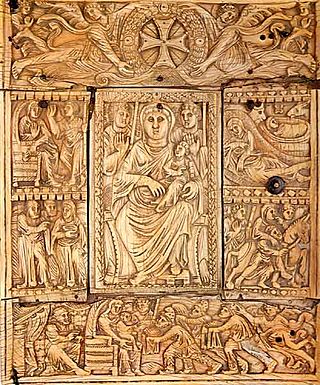Top Qs
Timeline
Chat
Perspective
Echmiadzin Gospels
From Wikipedia, the free encyclopedia
Remove ads
The Echmiadzin Gospels (Yerevan, Matenadaran, MS. 2374, formerly Etchmiadzin Ms. 229) is a 10th-century Armenian Gospel Book produced in 989[1] at the Monastery of Bgheno-Noravank in Syunik. Up to the 10th century, eight dated Armenian Gospel manuscripts have survived: the Gospels of Queen Mlké (851-862) (Venice № 1144/86), the Lazarian Gospels (887) (Matenadaran № 6200), The Gospels of Ashot Sparapet (909) (Matenadaran № 6202), Dsurghut Gospels (974) (Georgia), the Sanasarian Gospels (985) (Matenadaran № 7735), Sk'antchelagorts Gospels (988) (Matenadaran № 8906), Ejmiadsin Gospels (989) (Matenadaran № 2374) and the Gospels of the Translators (966-996) (Walters Art Gallery).[2]

Remove ads
The book
The manuscript has 232 extant leaves which measure approximately 32 by 25.5 cm. The book was made under the patronage of Bishop Stepanos and written by the scribe Hovhanes. The binding of the book is made of two carved ivory plaques, probably of Byzantine manufacture of the 6th century. Bound into the book are two leaves (fols. 228–229) with miniatures dating to the late 6th—early 7th century (so-called 'Final Four Miniatures').
Remove ads
Eusebian Canons

The art historian Carl Nordenfalk considered the Eusebian canon tables in the Echmiadzin Gospels (fols. 1–5, including the Eusebian letter) to be the best representative of the original table design (column arrangement, pattern of frame, ornament, etc.) developed in Caesarea Palaestina at the time of Eusebius (1st half of the 4th century). Taking into account the Caesarean type of the Armenian text of the Gospels, Nordenfalk concluded that the Echmiadzin Gospels were copied from a Caesarean codex equipped with the Eusebian canon tables.
Remove ads
References
External links
Wikiwand - on
Seamless Wikipedia browsing. On steroids.
Remove ads
